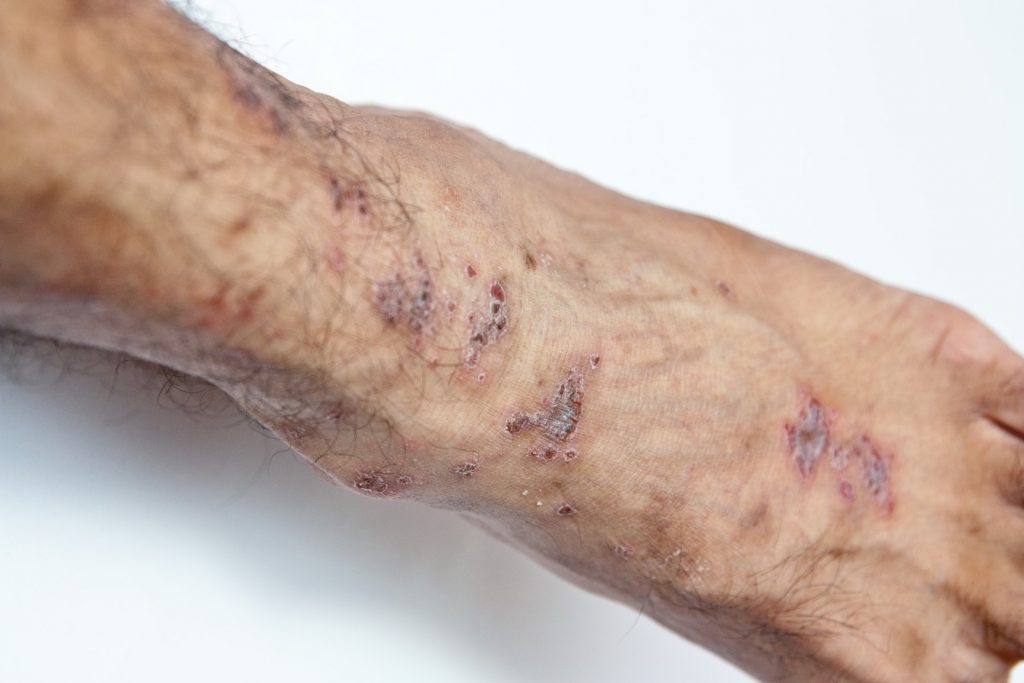- Home
- Vein Concerns
- Venous Eczema
Venous Eczema – Causes, Treatments & Prevention – Auckland NZ
Venous eczema (or varicose eczema) is a skin condition that usually appears as itchy dry skin on the lower leg. It can develop into a scaly or flaky red rash and in severe cases can lead to a venous ulcer. It is often associated with varicose veins, and won’t go away until the underlying condition is dealt with, such as the removal of affected veins.
Below we explain more about venous eczema causes, prevention and treatments including the non-surgical treatment of varicose veins.

What Causes Venous Eczema
Venous eczema occurs as a result of venous insufficiency. This is when veins in the body – in this case the legs – are not pumping blood back to the heart properly. This causes blood to collect in the blood vessels so they become enlarged (varicose). It also means that toxins and metabolites in the blood are not cleared properly, which can cause irritation and inflammation on the skin above the varicose vein, leading to venous eczema.
Other complications of venous insufficiency, in addition to varicose eczema, include a clot in the leg veins (known as deep vein thrombosis or DVT) and venous ulcers.
Venous eczema is more common in old people, in those who are overweight, and in those who have had multiple pregnancies. Other risk factors are high blood pressure, a lack of exercise, and sitting or standing for long periods of time.
Alongside skin irritation, symptoms may include heavy, aching or swollen legs. At first these symptoms tend to affect the ankles but left untreated will extend upward to the calf and may develop into weeping, cracked and painful skin, and in severe cases can lead to sores and venous leg ulcers.
When treating varicose eczema with different medications, the affected area can become sensitive and painful – a condition known as contact dermatitis.
Venous Eczema Treatment
Venous eczema can become a lifelong condition if the underlying cause is not treated. Topical corticosteroid creams can treat the eczema temporarily but it will continue to recur until the associated varicose vein is removed.
At Palm Clinic in Auckland NZ, we are experts in the treatment of varicose veins and offer our clients treatments that require no surgery, no downtime from work and minimal aftercare. We have treated over 13,000 kiwis and pride ourselves on offering gold-standard techniques and the best modern technology for varicose vein removal. You can learn more about varicose vein treatment options here.
Venous Eczema Prevention
Although varicose eczema can’t be prevented, the frequency and severity of flare-ups can be contained by following these recommendations:
- Wearing a compression stocking or sock to help improve blood flow in the leg
- Avoid long periods of sitting and standing
- Elevate your legs while seated or relaxing
- Avoid using soap when washing
- Use emollients on the affected area to relieve dryness and itching
Venous Eczema Pictures
These are typical presentations of venous eczema – itchy, dry red skin that is beginning to turn crusty and scaly.

Vein care for confidence and comfort at every step.


Why Palm Clinic?
Our highly skilled medical team treat you with care and understanding.
or want to make an appointment?
139 Remuera Rd, Remuera
Auckland 1050
Ph 09 522 8128 | 0800 4 PALMCLINIC
[email protected]
Take advantage of our Interest Free Payment plans to cover the cost of your treatment.
To apply online go to: www.qmastercard.co.nz and click on APPLY NOW
Talk to our staff today to find out more about our flexible payment options.
* Lending criteria, fees, terms and conditions apply.


Please note that individual results may vary from patient to patient and the information provided on our website is only a guide to possible results.
© 2022 Palm Clinic / Privacy Policy / Login
